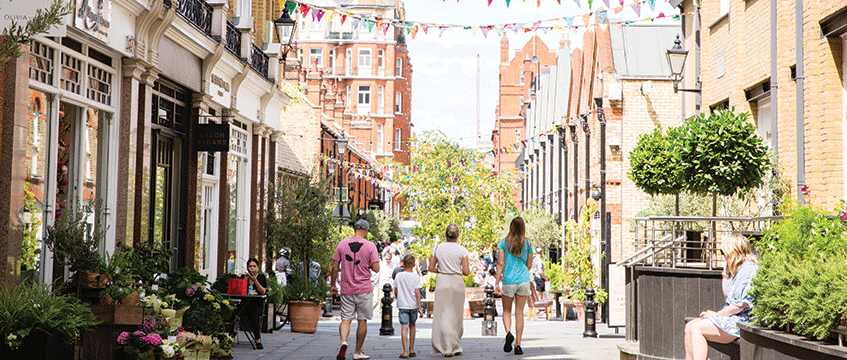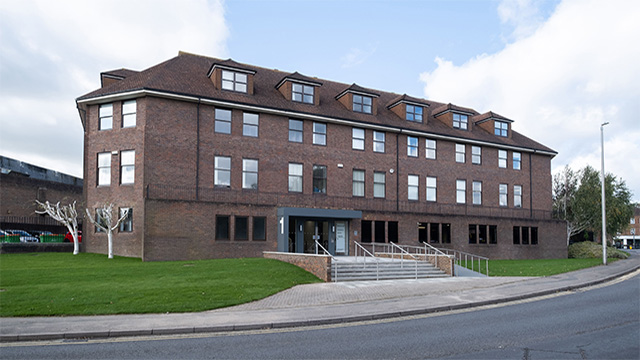Made in Chelsea: Cadogan on communication and community
News
by
Kate Neale and Giles Semper
COMMENT The importance of a sense of community, pride and ownership over a space is fundamental to its success. Spaces are only places if people make them so.
How do you create this emotional connection and enable a thriving sense of place? In a fragmented, post-pandemic society it can appear to be a challenging job, and unfortunately there’s been a growing disconnect between what’s available on our high streets and what residents want. Across the country, there are persistently high vacancy rates and footfall has generally not recovered since 2019.
Communication is integral to reinvigorating neighbourhoods. Through it we can join the dots between residents, high street businesses and visitors. As long-term stewards of a large estate, Cadogan has been part of the community in Chelsea for over three centuries.
COMMENT The importance of a sense of community, pride and ownership over a space is fundamental to its success. Spaces are only places if people make them so.
How do you create this emotional connection and enable a thriving sense of place? In a fragmented, post-pandemic society it can appear to be a challenging job, and unfortunately there’s been a growing disconnect between what’s available on our high streets and what residents want. Across the country, there are persistently high vacancy rates and footfall has generally not recovered since 2019.
Communication is integral to reinvigorating neighbourhoods. Through it we can join the dots between residents, high street businesses and visitors. As long-term stewards of a large estate, Cadogan has been part of the community in Chelsea for over three centuries.
However, as with all areas, Chelsea is in a constant process of evolution. Our residents and our businesses love the area but each needs to thrive if the other is to prosper. Maintaining that symbiotic relationship requires a regular flow of information between both businesses and people.
Village hub
The marketplace is constantly changing and the demands for spaces to be adaptable and flexible to meet people’s changing requirements is increasing. To embrace change, we need to listen to the views of those who live, work and visit here.
Pavilion Road is a great example of communication-led placemaking. When it was developed in 2016, the council’s advice was that it should offer only residential accommodation. Residents felt differently, clearly stating they wanted a “high street” offering staple foodstuffs and other essential retail. By incorporating a blend of independent shops, such as a butcher, baker and cheesemonger, combined with striking architecture, extensive planting and al fresco seating, this part of Chelsea has been transformed into a “village hub”.
During the pandemic Pavilion Road offered a place to see neighbours, to access essential retail and to enjoy food or drink on the street. Following permanent pedestrianisation in 2021, it has become the new beating heart of the neighbourhood.
On a grander scale, our long-term sustainability strategy for the area, Chelsea 2030, has also drawn heavily on the views of our community. In designing this sustainability vision, we wanted to reach beyond the “usual suspects”.
Gone were meetings in draughty halls. In their place were digital surveys for residents and visitors delivered via social media and the Built-ID platform, stakeholder workshops and face-to-face business interviews. This method of co-creation has led to high engagement levels and ensured we are responding directly to our community’s environmental and social concerns. With 69% stating air quality was their greatest concern, it’s no surprise that a freight and logistics project to tackle local congestion and air pollution received strong support and is now delivering tangible impacts.
No complacency
Communication also remains vital to create inclusive spaces. From the provision of destination access guides to support those with access needs so they can plan their visit to Chelsea, to community input shaping the design of an entire high street, two-way communication is essential.
More recently, the transformation of Sloane Street (pictured) owes much to the input of local businesses. Retailers wanted a public realm that offers a pleasant pedestrian environment, with level access, biodiverse and climate-friendly planting and improved visual amenities. More specifically, they helped shape the design of the “arts and crafts” inspired lamp posts, and the elegant planters that serve to green the street, offer seating and crucially act as significant security measures from the threat of ram-raiding.
At the time of writing, Cadogan’s year-to-date footfall figures have returned to similar levels as recorded in 2019 and sales are up – a dramatic contrast to other parts of the West End. Businesses tell us that residents stayed loyal during the pandemic and show no signs of wavering. We feel no sense of complacency because tomorrow could be different. But as long as we listen to the people that make Chelsea a unique place, the area will continue to evolve and thrive.
Kate Neale is head of sustainability and Giles Semper is head of place at Cadogan
Image © Cadogan











